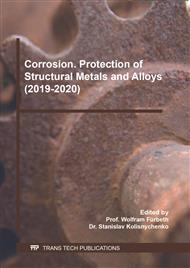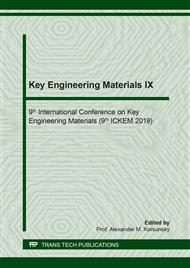[1]
F.Alizadegan, S.M. Mirabedini, S. Pazokifard, Improving self-healing performance of polyurethane coatings using PU microcapsules containing bulky-IPDI-BA and nano-clay, Progress in Organic Coatings, 123 (2018) 350-361.
DOI: 10.1016/j.porgcoat.2018.07.024
Google Scholar
[2]
D.G. Bekas, K. Tsirka, D. Baltzis, Self-healing materials: A review of advances in materials, evaluation, characterization and monitoring techniques, Composites Part B: Engineering, 87 (2016) 92-119.
DOI: 10.1016/j.compositesb.2015.09.057
Google Scholar
[3]
M. Behzadnasab, M. Esfandeh, S.M. Mirabedini, Preparation and characterization of linseed oil-filled urea–formaldehyde microcapsules and their effect on mechanical properties of an epoxy-based coating, Colloids and Surfaces A: Physicochemical and Engineering Aspects, 457 (2014) 16-26.
DOI: 10.1016/j.colsurfa.2014.05.033
Google Scholar
[4]
B. Dong, Y. Wang, G. Fang, N. Smart releasing behavior of a chemical self-healing microcapsule in the stimulated concrete pore solution, Cement and Concrete Composites, 56 (2015) 46-50.
DOI: 10.1016/j.cemconcomp.2014.10.006
Google Scholar
[5]
N.A. Siddiqui, J.K. Kim, F. Muzaffar, A. Munir, Self-Healing Glass Fibres with Carbon Nanotube-Epoxy Nanocomposite Coating,Key Engineering Materials, 334-335 (2007) 805-808.
DOI: 10.4028/www.scientific.net/kem.334-335.805
Google Scholar
[6]
Y. Liu, A. Chattopadhyay, Self-healing nanocomposite using shape memory polymer and carbon nanotubes, Proceedings of SPIE - The International Society for Optical Engineering, 8692 (2013) 869205.
Google Scholar
[7]
Y. Zhu, X.J. Ye, M.Z. Rong, M.Q. Zhang, Self-healing glass fiber/epoxy composites with polypropylene tubes containing self-pressurized epoxy and mercaptan healing agents, Composites Science & Technology, 135 (2016) 146-152.
DOI: 10.1016/j.compscitech.2016.09.020
Google Scholar
[8]
J.L. Mercy, S. Prakash, A. Krishnamoorthy, S. Ramesh, D.A. Anand, Multi response optimisation of mechanical properties in self-healing glass fiber reinforced plastic using grey relational analysis,Measurement, 110 (2017) 344-355.
DOI: 10.1016/j.measurement.2017.07.013
Google Scholar
[9]
F. Sordo, V. Michaud, Processing and damage recovery of intrinsic self-healing glass fiber reinforced composites, Smart Materials & Structures, 25 (2016) 084012.
DOI: 10.1088/0964-1726/25/8/084012
Google Scholar
[10]
C.H. Xue, Z.D. Zhang, J. Zhang, S.T. Jia, Lasting and self-healing superhydrophobic surfaces by coating of polystyrene/SiO2 nanoparticles and polydimethylsiloxane,Journal of Materials Chemistry A, 2 (2014) 15001-15007.
DOI: 10.1039/c4ta02396j
Google Scholar
[11]
J. Wu, M.D. Weir, M.A. Melo, H.H. Xu, Development of novel self-healing and antibacterial dental composite containing calcium phosphate nanoparticles,Journal of Dentistry, 43 (2015) 317-326.
DOI: 10.1016/j.jdent.2015.01.009
Google Scholar
[12]
G. Wu, J. An, D. Sun, X. Tang, Y. Xiang, J. Yang, Robust microcapsules with polyurea/silica hybrid shell for one-part self-healing anticorrosion coatings, Journal of Materials Chemistry A, 2 (2014) 11614-11620.
DOI: 10.1039/c4ta01312c
Google Scholar
[13]
Y.K. Song, C.M. Chung, Repeatable self-healing of a microcapsule-type protective coating,Polymer Chemistry, 4 (2013) 4940-4947.
DOI: 10.1039/c3py00102d
Google Scholar
[14]
C. Li, J. Tan, J. Gu, L. Qiao, B. Zhang, Q. Zhang, Rapid and efficient synthesis of isocyanate microcapsules via thiol-ene photopolymerization in Pickering emulsion and its application in self-healing coating, Composites Science and Technology, 123 (2016) 250-258.
DOI: 10.1016/j.compscitech.2016.01.001
Google Scholar
[15]
L.I. Qi, A.K. Mishra, N.H. Kim, KUILA, Tapas, Effects of processing conditions of poly(methylmethacrylate) encapsulated liquid curing agent on the properties of self-healing composites, Composites Part B Engineering, 49 (2013) 6-15.
DOI: 10.1016/j.compositesb.2013.01.011
Google Scholar
[16]
W. Wang, L. Xu, X. Li, Y. Yang, E. An, Self-healing properties of protective coatings containing isophorone diisocyanate microcapsules on carbon steel surfaces, Corrosion Science, 80 (2014) 528-535.
DOI: 10.1016/j.corsci.2013.11.050
Google Scholar
[17]
M. Hasanzadeh, M. Shahidi, M. Kazemipour, Application of EIS and EN techniques to investigate the self-healing ability of coatings based on microcapsules filled with linseed oil and CeO2 nanoparticles, Progress in Organic Coatings, 80 (2015) 106-119.
DOI: 10.1016/j.porgcoat.2014.12.002
Google Scholar
[18]
M. Huang, J. Yang, Salt spray and EIS studies on HDI microcapsule-based self-healing anticorrosive coatings, Progress in Organic Coatings, 77 (2014) 168-175.
DOI: 10.1016/j.porgcoat.2013.09.002
Google Scholar



